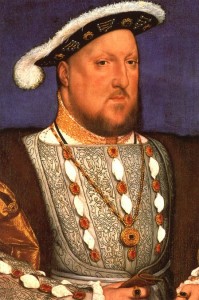 According to Eustace Chapuys, the imperial ambassador, on 27th April 1536 John Stokesley, Bishop of London, was consulted for advice regarding whether the King could set aside his marriage to Anne Boleyn. Chapuys wrote to Charles V:
According to Eustace Chapuys, the imperial ambassador, on 27th April 1536 John Stokesley, Bishop of London, was consulted for advice regarding whether the King could set aside his marriage to Anne Boleyn. Chapuys wrote to Charles V:
“The brother of lord Montague told me yesterday at dinner that the day before the bishop of London had been asked if the King could abandon the said concubine, and he would not give any opinion to anyone but the King himself, and before doing so he would like to know the King’s own inclination, meaning to intimate that the King might leave the said concubine, but that, knowing his fickleness, he would not put himself in danger. The said Bishop was the principal cause and instrument of the first divorce, of which he heartily repents, and would still more gladly promote this, the said concubine and all her race are such abominable Lutherans. London, 29 April 1536.”1
As Chapuys says, he had heard the news from Geoffrey Pole, brother of Henry Pole, Baron Montagu, and Cardinal Reginald Pole. The Poles were part of a group of Catholic conservatives which consisted of the Seymours, Sir Nicholas Carew, the Marquis and Marchioness of Exeter, and the Countess of Kildare. Historian Eric Ives believes that Chapuys probably brought Cromwell and the Conservatives together when it became apparent that they were both working towards the same purpose: a reconciliation between Henry VIII and the Emperor, and the restoration of Mary.2 I think that Cromwell was a pragmatist. He could see that Anne was going down and could easily take him with her if he didn’t join the other side. After Anne’s fall, he then worked to free himself from the conservative faction by implicating them in plots concerning Mary.
Notes and Sources
- LP x. 752 (Letters and Papers, Foreign and Domestic, Henry VIII)
- Ives, Eric (2004) The Life and Death of Anne Boleyn, p317
This is what I would call sounding out how the land lay. Sounding out the opposite party to the Queen is a good way of attempting to work out the Kings mind and given that Henry had probably confided in Carew, his old jousting buddy, they had confided in the power people at court the kings cousins the Poles, I believe this was a true gage of what Henry had in mind, maybe looking to divorce Anne, rather than the cruel route he went down a few days later, to have her arrested and executed.
I doubt Henry planned to kill Anne all along, but this is another case of fail and die. Anne’s position was much more like Cromwell’s and Wolsey’s. There were many who wanted her dead, as that was the only way to be sure she would not avenge herself. Henry could not have been willing to have another situation where he had a divorced wife hanging around making claims, and potentially damaging the legitimacy of his new brood. Cromwell and Anne had already had a falling out, and he would have wanted to be sure of a result that would satisfy his master. Henry would never have volunteered himself for horns. Cromwell fixed it so Henry had his cake and could eat it.